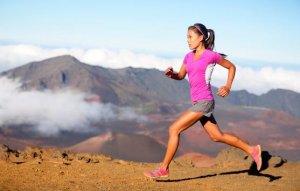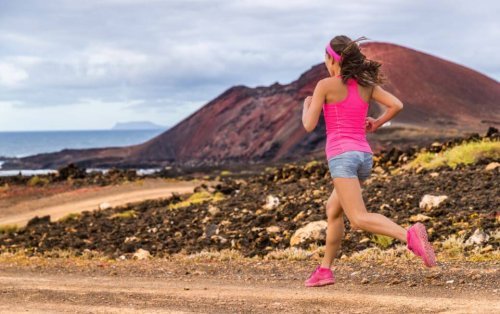Everything You Need for Mountain Running

People who love nature and physical exercise can combine these two passions in one single sport: mountain running. However, like so many other sports, this has its basic requirements. Do you know exactly what you need to run on a mountain?
With the passage of time, just as has happened with other sports, the equipment for pedestrian sports has evolved. This especially includes mountain running, which adds even more external difficulties to the mere physical demand it takes.
Therefore, in order to mitigate discomforts, pains, and difficulties, materials have been made increasingly lighter, protective, and useful. If you’re experienced in this sport, you may already know and use them. For beginners, the following list of things you need to run on a mountain can be very helpful.
What do you need to run on a mountain?
Mountain runners must have certain and specific instruments to be able to focus exclusively on their own improvement and nothing else. These are the elements that can’t be missing:
1. Shoes
Shoes are, of course, the main “tool” for all runners. There are many models on the market that vary in resistance, lightness, and shape. However, there is a universal feature to all of them: comfort can’t be lacking.
Although it’s a very personal choice, it’s best to choose shoes that aren’t too heavy, but also resistant. Additionally, they must have an optimal grip. The last thing we want is a fall that prevents us from continuing, especially when running on slopes.
2. Clothing
Just like the shoes, a mountain runner’s clothing has specific requirements for the activity. Broadly speaking, clothing is sought to protect from wind and rain, since weather conditions are always liable to change.

For the lower body, tight-fitting garments, such as tights, are useful. These allow for better mobility and don’t get caught in the surrounding shrubbery that you may find on the trail.
In cold weather, consider wearing caps and collars, as well as thermal shirts. Long socks are also great allies of mountain runners.
3. Backpack
Carrying a backpack will depend on the distances you travel and the time you spend in one place. Although, whenever you have the opportunity to carry a light and practical one, it would be advisable to do so.
The main feature of a backpack for mountain running is its compartments, which will give you the ability to store useful things. These can include a canteen or water bottle, glasses, extra clothes, a rain jacket, first aid items, and fruits.
Many runners also include a spare pair of shoes. It’s a very wise precaution to avoid unexpected surprises, especially if you are wearing new shoes. You can choose to carry others that are made for different surfaces; that way, you’ll be ready to face whichever terrain you come across.
Try to carry only the essentials, since running uphill can become complicated with extra pounds on your back. Moreover, this will be very draining for your muscles and could cause injuries.
4. Location instruments
A classic map can’t be missing from your backpack; neither can a good old compass! However, if you have a GPS device, taking it is a great idea. You can install applications that will allow you to record your progress.
It’s very important that you stay located at all times so as not to leave the route you have drawn out. Running the wrong way could mean several hours of delay; even worse, you could get into dangerous areas.
5. Accessories
Here, we will include very practical elements, but they will depend on the preferences of each runner. First of all, leggings for runners. These will prevent the entry of stones and dirt into your shoes, which is incredibly uncomfortable.
Furthermore, it’s good to use caps and glasses to protect your face and eyes from the sun. Remember to keep your eyes on the ground to avoid falling. If the sun is in front of you, the chances of suffering a fall will increase.

Final tips for running in the mountains
A common mistake of many asphalt runners is switching to mountain running without taking proper precautions. You must remember that mountain conditions vary. Furthermore, the highly irregular surface can cause foot injuries if the proper technique isn’t applied.
Finally, just like with any physical activity, try to advance moderately. The gradual progress through the acceptance of our capabilities and limits is just as important, or even more so than all the accessories you need to run in the mountains.
Once you have all of this down, you’ll be ready to experience this sport and take advantage of its enormous benefits. As a final tip, remember to notify someone of your route and bring a mobile phone in case you decide to go out and exercise on your own.
People who love nature and physical exercise can combine these two passions in one single sport: mountain running. However, like so many other sports, this has its basic requirements. Do you know exactly what you need to run on a mountain?
With the passage of time, just as has happened with other sports, the equipment for pedestrian sports has evolved. This especially includes mountain running, which adds even more external difficulties to the mere physical demand it takes.
Therefore, in order to mitigate discomforts, pains, and difficulties, materials have been made increasingly lighter, protective, and useful. If you’re experienced in this sport, you may already know and use them. For beginners, the following list of things you need to run on a mountain can be very helpful.
What do you need to run on a mountain?
Mountain runners must have certain and specific instruments to be able to focus exclusively on their own improvement and nothing else. These are the elements that can’t be missing:
1. Shoes
Shoes are, of course, the main “tool” for all runners. There are many models on the market that vary in resistance, lightness, and shape. However, there is a universal feature to all of them: comfort can’t be lacking.
Although it’s a very personal choice, it’s best to choose shoes that aren’t too heavy, but also resistant. Additionally, they must have an optimal grip. The last thing we want is a fall that prevents us from continuing, especially when running on slopes.
2. Clothing
Just like the shoes, a mountain runner’s clothing has specific requirements for the activity. Broadly speaking, clothing is sought to protect from wind and rain, since weather conditions are always liable to change.

For the lower body, tight-fitting garments, such as tights, are useful. These allow for better mobility and don’t get caught in the surrounding shrubbery that you may find on the trail.
In cold weather, consider wearing caps and collars, as well as thermal shirts. Long socks are also great allies of mountain runners.
3. Backpack
Carrying a backpack will depend on the distances you travel and the time you spend in one place. Although, whenever you have the opportunity to carry a light and practical one, it would be advisable to do so.
The main feature of a backpack for mountain running is its compartments, which will give you the ability to store useful things. These can include a canteen or water bottle, glasses, extra clothes, a rain jacket, first aid items, and fruits.
Many runners also include a spare pair of shoes. It’s a very wise precaution to avoid unexpected surprises, especially if you are wearing new shoes. You can choose to carry others that are made for different surfaces; that way, you’ll be ready to face whichever terrain you come across.
Try to carry only the essentials, since running uphill can become complicated with extra pounds on your back. Moreover, this will be very draining for your muscles and could cause injuries.
4. Location instruments
A classic map can’t be missing from your backpack; neither can a good old compass! However, if you have a GPS device, taking it is a great idea. You can install applications that will allow you to record your progress.
It’s very important that you stay located at all times so as not to leave the route you have drawn out. Running the wrong way could mean several hours of delay; even worse, you could get into dangerous areas.
5. Accessories
Here, we will include very practical elements, but they will depend on the preferences of each runner. First of all, leggings for runners. These will prevent the entry of stones and dirt into your shoes, which is incredibly uncomfortable.
Furthermore, it’s good to use caps and glasses to protect your face and eyes from the sun. Remember to keep your eyes on the ground to avoid falling. If the sun is in front of you, the chances of suffering a fall will increase.

Final tips for running in the mountains
A common mistake of many asphalt runners is switching to mountain running without taking proper precautions. You must remember that mountain conditions vary. Furthermore, the highly irregular surface can cause foot injuries if the proper technique isn’t applied.
Finally, just like with any physical activity, try to advance moderately. The gradual progress through the acceptance of our capabilities and limits is just as important, or even more so than all the accessories you need to run in the mountains.
Once you have all of this down, you’ll be ready to experience this sport and take advantage of its enormous benefits. As a final tip, remember to notify someone of your route and bring a mobile phone in case you decide to go out and exercise on your own.
This text is provided for informational purposes only and does not replace consultation with a professional. If in doubt, consult your specialist.








